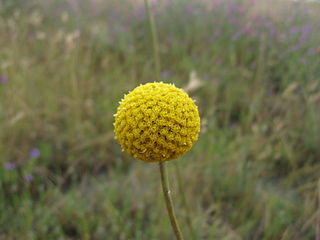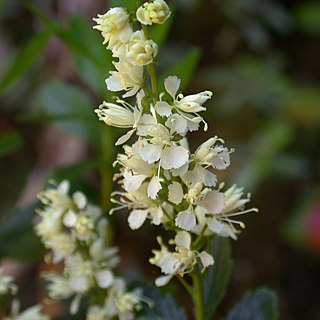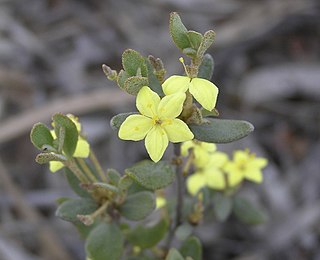Related Research Articles

George Bentham was an English botanist, described by the weed botanist Duane Isely as "the premier systematic botanist of the nineteenth century". Born into a distinguished family, he initially studied law, but had a fascination with botany from an early age, which he soon pursued, becoming president of the Linnaean Society in 1861, and a fellow of the Royal Society in 1862. He was the author of a number of important botanical works, particularly flora. He is best known for his taxonomic classification of plants in collaboration with Joseph Dalton Hooker, his Genera Plantarum (1862–1883). He died in London in 1884.

Luina, commonly called silverback, is a small genus of perennial shrubs in the groundsel tribe within the sunflower family.
Dicoelia is a plant genus of the family Phyllanthaceae. It was first described as a genus in 1879. It is native to Borneo and Sumatra.
- Dicoelia beccarianaBenth. - Borneo
- Dicoelia sumatranaWelzen - Sumatra

Pycnosorus is a genus of six species of plants in the daisy family Asteraceae. Commonly known as billy buttons or drumsticks, they are annual or perennial herbs or small shrubs with a cylindrical to spherical head of up to 200 daisy-like "flowers". Each "flower" is a pseudanthium consisting of between three and eight florets surrounded by bracts. The petals are joined to form a small tube and the florets with their surrounding bracts are yellow or golden-yellow.
Oncocalamus is a monoecious genus of flowering plants in the palm family found in western Africa. The genus is the lone member of the Oncocalaminae; once placed with the vegetatively similar Eremospatha and Laccosperma in the Ancistrophyllinae, it is now isolated based on their unusual flowers and arrangement. Such a placement argues for a long and complex evolutionary process in the Calamoideae with heavy extinction rates. The Greek genus name combines "horn" and "capsule".
Plagiosetum is a genus of plants in the grass family. The only known species is Plagiosetum refractum, found in Queensland, Northern Territory, South Australia, Western Australia, and New South Wales.
Aciachne is a genus of Latin American plants in the grass family.
Craspedorhachis is a genus of African plants in the grass family.
Oxylaena is a genus of flowering plants in the pussy's-toes tribe within the sunflower family.
Leptaulus is a genus of trees and shrubs in the family Cardiopteridaceae described as a genus in 1862. It is native to tropical Africa including Madagascar.
Heterachne is a genus of Australian plants in the grass family.
Desmanthodium is a genus of flowering plants in the daisy family.
Ondetia is a genus of flowering plants in the spikenard tribe within the daisy family.
Stachycephalum is a genus of plants in the family Asteraceae.
Chiliocephalum is a genus of Ethiopian flowering plants in the aster family.
Axiniphyllum is a genus of flowering plants in the daisy family.

Tetracarpaea is the only genus in the flowering plant family Tetracarpaeaceae. Some taxonomists place it in the family Haloragaceae sensu lato, expanding that family from its traditional circumscription to include Penthorum and Tetracarpaea, and sometimes Aphanopetalum as well.
Camptacra gracilis is a species of flowering plants in the daisy family. It is native to northern Australia, and to the island of New Guinea.

Daviesia divaricata, commonly known as marno, is a species of flowering plant in the family Fabaceae and is endemic to the south-west of Western Australia. It is a low, spreading or erect and bushy shrub with phyllodes reduced to small, triangular scales, and orange and maroon flowers.

Asterolasia squamuligera, commonly known as yellow starbush, is a species of erect, woody, slender perennial shrub that is endemic to the southwest of Western Australia. It has leathery, egg-shaped leaves with the narrower end towards the base and yellow flowers arranged in umbels of five to ten with a fringe of scales on the back of the petals, and about ten stamens.
References
- 1 2 3 "Flann, C (ed) 2009+ Global Compositae Checklist". Archived from the original on 2014-11-11. Retrieved 2014-11-11.
- ↑ Bentham, George. 1872. Hooker's Icones Plantarum 12: plate 1111 line drawing of Calostephane divaricata
- ↑ Bentham, George. 1872. Hooker's Icones Plantarum 12: pages 10-11 descriptions in Latin, commentary in English
- 1 2 3 Calostephane. Flora of Zimbabwe.
- ↑ Calostephane. The Plant List.